 Our final day in Paris and our destination is The Musee du Louvre. This is by far one of the largest museums that my students have visited, and the layout is both daunting and a bit overwhelming. Before entering the museum we had some time to enjoy the famous entry pyramid designed by renowned architect I.M. Pei and admire the courtyard of the former palace. Once inside we were able to appreciate the beauty of the winding staircase with the integrated elevator to accommodate visitors with disabilities. A new feature that we experienced was the hand-held individual audio/visual guides. These proved to be extremely useful and both simplified and assisted the process of navigating through the museum. There is a bit of a learning curve with these devices depending on your generation.
Our final day in Paris and our destination is The Musee du Louvre. This is by far one of the largest museums that my students have visited, and the layout is both daunting and a bit overwhelming. Before entering the museum we had some time to enjoy the famous entry pyramid designed by renowned architect I.M. Pei and admire the courtyard of the former palace. Once inside we were able to appreciate the beauty of the winding staircase with the integrated elevator to accommodate visitors with disabilities. A new feature that we experienced was the hand-held individual audio/visual guides. These proved to be extremely useful and both simplified and assisted the process of navigating through the museum. There is a bit of a learning curve with these devices depending on your generation. 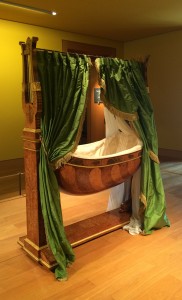 That is because they are actual Nintendo controllers. If you were a fan of these video games, then you were at a terrific advantage. In any case, even though I am not quite from the Nintendo age I did enjoy an occasional Mario Brothers game in my time, and found these audio guides to be very useful and practical. Their built in GPS system meant they could determine your location in the museum and either guide you to the next exhibit, or pause to share information on your current location.
That is because they are actual Nintendo controllers. If you were a fan of these video games, then you were at a terrific advantage. In any case, even though I am not quite from the Nintendo age I did enjoy an occasional Mario Brothers game in my time, and found these audio guides to be very useful and practical. Their built in GPS system meant they could determine your location in the museum and either guide you to the next exhibit, or pause to share information on your current location. 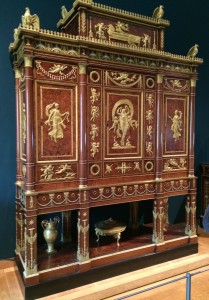 Brilliant in my estimation. There are some exhibits I never grow weary of. These include the Nike of Samothrace, which had undergone a recent restoration, the apartments of Napoleon, and of course the Mona Lisa. What a wonderful end to our beautiful Paris visit. Of course there is much more to see and do in Paris, but the students have a strong
Brilliant in my estimation. There are some exhibits I never grow weary of. These include the Nike of Samothrace, which had undergone a recent restoration, the apartments of Napoleon, and of course the Mona Lisa. What a wonderful end to our beautiful Paris visit. Of course there is much more to see and do in Paris, but the students have a strong 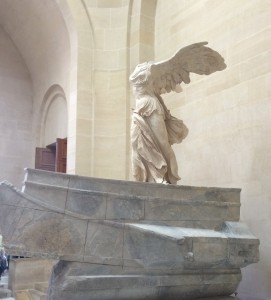 introduction to the sights and the rich history. I remind them to start taking note of what they want to visit on their return trip to Paris….because a single visit cannot be enough! Our coach bus picked us up outside the Louvre and we were off to the train station to take the Eurostar to London. As we pass Garnier’s Opera house one last time I bid a fond farewell to one of my favorite cities. Now on to the next adventure….much excitement still ahead for us!
introduction to the sights and the rich history. I remind them to start taking note of what they want to visit on their return trip to Paris….because a single visit cannot be enough! Our coach bus picked us up outside the Louvre and we were off to the train station to take the Eurostar to London. As we pass Garnier’s Opera house one last time I bid a fond farewell to one of my favorite cities. Now on to the next adventure….much excitement still ahead for us!
Category Archives: Global Perspective
A Visit to a Famous Paris Cemetery
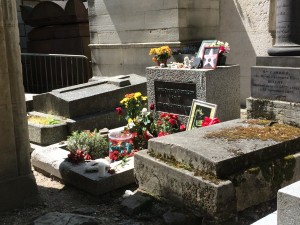 On any student study abroad trip for college age participants, free time must be factored in. Here, a good tour guide can be a tremendous help, providing suggestions and travel routes so that each individual can make the most of this valuable time. Prior to the Villa trip, I met with students several times and I had already provided some options for consideration.
On any student study abroad trip for college age participants, free time must be factored in. Here, a good tour guide can be a tremendous help, providing suggestions and travel routes so that each individual can make the most of this valuable time. Prior to the Villa trip, I met with students several times and I had already provided some options for consideration. 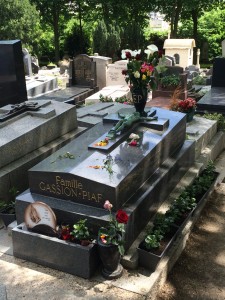 One of these included a visit to the Cimetiere du Pere Lachaise. Here is the final resting place for Jim Morrison, lead singer of The Doors, who died in Paris in 1971 at the age of 27. Several students were interested in this option and so a few of us ventured out. The cemetery is a very unique place by our standards. It is difficult to describe because you are likely to do it an injustice. Considered Paris’ most prestigious cemetery, it is set on a wooded hill overlooking the city. It is a very peaceful place, with tremendous history evidenced by the markers and striking funetary sculpture
One of these included a visit to the Cimetiere du Pere Lachaise. Here is the final resting place for Jim Morrison, lead singer of The Doors, who died in Paris in 1971 at the age of 27. Several students were interested in this option and so a few of us ventured out. The cemetery is a very unique place by our standards. It is difficult to describe because you are likely to do it an injustice. Considered Paris’ most prestigious cemetery, it is set on a wooded hill overlooking the city. It is a very peaceful place, with tremendous history evidenced by the markers and striking funetary sculpture 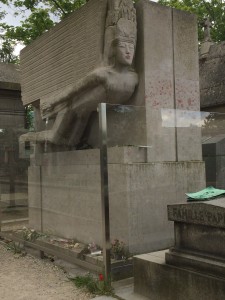 but also extremely dense, which makes it a bit difficult to locate some of the sites. During our brief visit we paid respects to Jim Morrison, Edith Piaf and Oscar Wilde. It was quite clear that people visit those sites often. In the case of both Morrison and Wilde protective enclosures have been erected. Nonetheless you can see the evidence of their admirers. As our cemetery visit drew to a close, we were happy that our free time would allow for a bit of shopping as well. Onward to the Paris Metro….next stop the Galeries Lafayette and then on to our evening visit at the Musee D’Orsay. As you can tell… another full day in Paris!
but also extremely dense, which makes it a bit difficult to locate some of the sites. During our brief visit we paid respects to Jim Morrison, Edith Piaf and Oscar Wilde. It was quite clear that people visit those sites often. In the case of both Morrison and Wilde protective enclosures have been erected. Nonetheless you can see the evidence of their admirers. As our cemetery visit drew to a close, we were happy that our free time would allow for a bit of shopping as well. Onward to the Paris Metro….next stop the Galeries Lafayette and then on to our evening visit at the Musee D’Orsay. As you can tell… another full day in Paris!
Montmartre and Sacre Coeur In the Morning
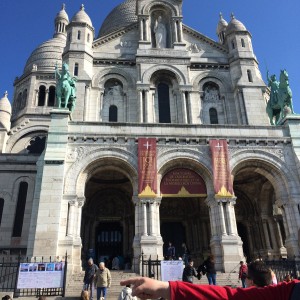 Travel tip to organizers – I always want a planned activity first thing in the morning. Breakfast between 7:00 and 8:00 and meeting in the lobby no later than 9:00 am. This is my way of knowing that everyone in the group is up and about for another day, and I can check in with each participant for any information they may need to share.
Travel tip to organizers – I always want a planned activity first thing in the morning. Breakfast between 7:00 and 8:00 and meeting in the lobby no later than 9:00 am. This is my way of knowing that everyone in the group is up and about for another day, and I can check in with each participant for any information they may need to share. 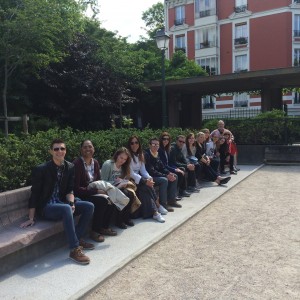 On this third day of our trip we are heading up to Montmartre and Sacre Coeur. Visiting in the morning is quite a different experience. The streets are relatively empty, the street sellers have not yet arrived, there are no entertainers on the steps, and there is a lovely sense of calm. Visiting later in the day you find a noisy, boisterous crowd which is strangely juxtaposed with the beautiful serenity of the church.
On this third day of our trip we are heading up to Montmartre and Sacre Coeur. Visiting in the morning is quite a different experience. The streets are relatively empty, the street sellers have not yet arrived, there are no entertainers on the steps, and there is a lovely sense of calm. Visiting later in the day you find a noisy, boisterous crowd which is strangely juxtaposed with the beautiful serenity of the church.
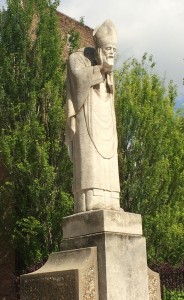 After taking the funiculaire up the hillside our tour guide shared the history of the area including the story of St. Denis. We walked through the church and students were quick to make comparisons with Notre Dame. They concluded that both cathedrals were beautiful in their own way and should definitely be visited by all. Our walk around Montmartre took us to places I had not visited before, including the sculpture of the man who could walk through walls. And who knew we would find lawn bowling lanes that included the sculpture of St. Denis holding his head? The only vineyard in Paris is also located in Montmartre.
After taking the funiculaire up the hillside our tour guide shared the history of the area including the story of St. Denis. We walked through the church and students were quick to make comparisons with Notre Dame. They concluded that both cathedrals were beautiful in their own way and should definitely be visited by all. Our walk around Montmartre took us to places I had not visited before, including the sculpture of the man who could walk through walls. And who knew we would find lawn bowling lanes that included the sculpture of St. Denis holding his head? The only vineyard in Paris is also located in Montmartre. 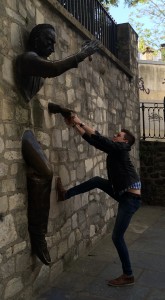 We had free time for lunch and shopping and the students enjoyed seeing the local artists painting, drawing and selling their work in the open courtyard. A small ceramics store sells the work of local artists and is a perennial favorite of mine. I also direct the students to this shop because their prices are reasonable, their products are unique, and this is a lovely purchase to bring home as a gift. We concluded our visit by strolling down the hill to the famous Moulin Rouge.
We had free time for lunch and shopping and the students enjoyed seeing the local artists painting, drawing and selling their work in the open courtyard. A small ceramics store sells the work of local artists and is a perennial favorite of mine. I also direct the students to this shop because their prices are reasonable, their products are unique, and this is a lovely purchase to bring home as a gift. We concluded our visit by strolling down the hill to the famous Moulin Rouge. 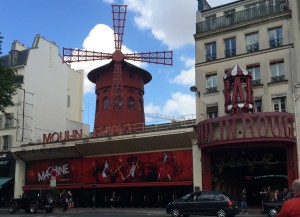 From here we had the afternoon on our own to spend shopping and sightseeing before we would meet as a group to tour the Musee D’Orsay. A few students were interested in a visit to a famous cemetery to pay their respect to Jim Morrison, among others. I joined them as their chaperone for this small adventure.
From here we had the afternoon on our own to spend shopping and sightseeing before we would meet as a group to tour the Musee D’Orsay. A few students were interested in a visit to a famous cemetery to pay their respect to Jim Morrison, among others. I joined them as their chaperone for this small adventure.
Eiffel Tower and Arc de Triomphe – capping off the second day in Paris
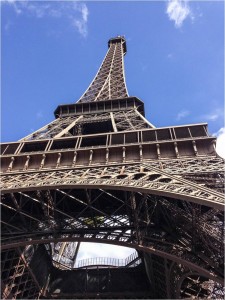 The Eiffel Tower is undoubtedly one of the most popular tourist destinations in Paris. Reservations can be difficult to come by at a reasonable price and must be booked well in advance. However, if you visit in the evening you will have much shorter lines, and if you are lucky enough to have a sunny evening following a rainy day you are going to fare even better. We had a very brief wait to take the first lift which will take you to the second floor of the tower. Even from this level the views are wonderful, and there is a little gift shop there. We were fortunate to have tickets to the summit.
The Eiffel Tower is undoubtedly one of the most popular tourist destinations in Paris. Reservations can be difficult to come by at a reasonable price and must be booked well in advance. However, if you visit in the evening you will have much shorter lines, and if you are lucky enough to have a sunny evening following a rainy day you are going to fare even better. We had a very brief wait to take the first lift which will take you to the second floor of the tower. Even from this level the views are wonderful, and there is a little gift shop there. We were fortunate to have tickets to the summit. 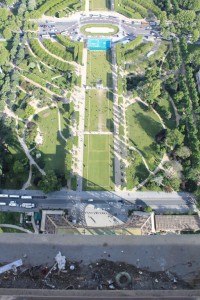 This required a longer wait, both going up and coming down. We were repeatedly reminded in several languages that pick-pockets were active in the tower and to watch all of our belongings. To the right is a view from the top, of the place we stood the day before to take our first group photo! The night was still young so we decided to take in a second iconic site which was the Arc de Triomphe. The history of the arch and the memories of battles, leaders and fallen soldiers was very moving. Many of the students were surprised by the height and mass of the arch.
This required a longer wait, both going up and coming down. We were repeatedly reminded in several languages that pick-pockets were active in the tower and to watch all of our belongings. To the right is a view from the top, of the place we stood the day before to take our first group photo! The night was still young so we decided to take in a second iconic site which was the Arc de Triomphe. The history of the arch and the memories of battles, leaders and fallen soldiers was very moving. Many of the students were surprised by the height and mass of the arch.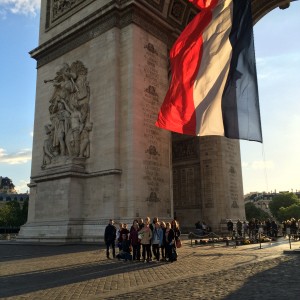 Again, a site that must be experienced and a visit that must place you beneath the arch, and at the tomb of the unknown soldier. The vistas down the radiating boulevards is also spectacular. Following our visit several of us stayed to stroll the Champs Elysee and have a fashionably late dinner at the Georges V. A wonderful end to our second day in Paris! Tomorrow will bring an early morning visit to Sacre Coeur and Montmartre.
Again, a site that must be experienced and a visit that must place you beneath the arch, and at the tomb of the unknown soldier. The vistas down the radiating boulevards is also spectacular. Following our visit several of us stayed to stroll the Champs Elysee and have a fashionably late dinner at the Georges V. A wonderful end to our second day in Paris! Tomorrow will bring an early morning visit to Sacre Coeur and Montmartre.
Villa Maria at Versailles!
 Getting to Versailles from Paris is simple on the trains, and it’s a short walk to the Palace. We were fortunate to leave the bad weather behind, at least for the stroll to the gates. The students were immediately surprised by the size of the Palace, and I knew that their awareness was still just a fragment of the true expanse and luxury. The best way to move through the rooms is with an individual audio guide.
Getting to Versailles from Paris is simple on the trains, and it’s a short walk to the Palace. We were fortunate to leave the bad weather behind, at least for the stroll to the gates. The students were immediately surprised by the size of the Palace, and I knew that their awareness was still just a fragment of the true expanse and luxury. The best way to move through the rooms is with an individual audio guide. 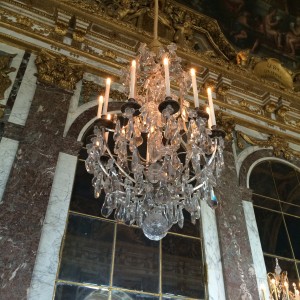 Keeping a large group together is more frustrating than helpful. We were fortunate to have a day that was less crowded, but that is a relative thing. Select a meeting place and meeting time and allow your members to move through the palace at their own pace. The large tour groups who follow a leader make it difficult for other guests and probably feel people jostling them throughout their visit. Seeing the opulence of the Palace made the French Revolution much more understandable for the Villa students.
Keeping a large group together is more frustrating than helpful. We were fortunate to have a day that was less crowded, but that is a relative thing. Select a meeting place and meeting time and allow your members to move through the palace at their own pace. The large tour groups who follow a leader make it difficult for other guests and probably feel people jostling them throughout their visit. Seeing the opulence of the Palace made the French Revolution much more understandable for the Villa students. 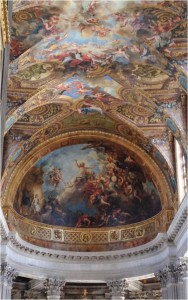 Visiting the private chambers and listening to descriptions of court life brought the monarchy to life, and students began to feel the place and space as it once had been. A few were able to visit the gardens, only to be caught in another downpour. Regardless of the inclement weather, the experience was wonderful and the lessons were powerful. As we left Versailles behind we began to prepare for the next adventure of the day. The poor weather was likely to work in our favor now. We decided we would head to the Eiffel Tower, where the lines were likely to be diminished, yet the clearing weather would give us wonderful views from the top of the tower!
Visiting the private chambers and listening to descriptions of court life brought the monarchy to life, and students began to feel the place and space as it once had been. A few were able to visit the gardens, only to be caught in another downpour. Regardless of the inclement weather, the experience was wonderful and the lessons were powerful. As we left Versailles behind we began to prepare for the next adventure of the day. The poor weather was likely to work in our favor now. We decided we would head to the Eiffel Tower, where the lines were likely to be diminished, yet the clearing weather would give us wonderful views from the top of the tower!
Getting Value from Study Abroad
Speak to most educators and they will agree, you cannot underestimate the value of experiential learning and where better to experience art and architecture but in Europe. Students at Villa Maria College had this opportunity for ten days in May, travelling to Paris and London. Some had traveled to Europe before for family holidays but most were visiting for the first time and in the end all had an experience that left them memories to last a lifetime. And in addition to the memories the students were also able to earn three credits towards their respective undergraduate degrees.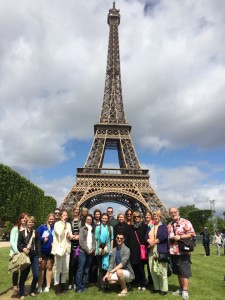 We had 19 participants on our trip which included Sandra Reicis, Associate Professor of Interior Design and trip coordinator, and Dr. Joycelyn Burdett, Assistant Professor Fashion Design and Merchandising serving as a second faculty chaperone. According to our group tour guide, this was one of the most ambitious and robust tours that he had led. Which gets us back to discussing value for the financial investment that a student makes in order to participate in study abroad. As in most cases, you will get out of your education something that is relative to what you have invested in it, and in most cases the investment I refer to is more personal than financial. Our ten day trip had an impressive itinerary. By most accounts it sounds like a month long trip. Prior to setting foot in Europe, students and their parents know that time will be used wisely and experiences will be varied and rich with wonderful sites, sounds and stories. After flying through the night with hopes that everyone gets a bit of sleep on the plane, a coach bus meets the group at the Paris airport and on the way into the city we start to see Paris unfold before us… and begin to learn about new things. A relatively quick bus tour of the city gives everyone their bearings.
We had 19 participants on our trip which included Sandra Reicis, Associate Professor of Interior Design and trip coordinator, and Dr. Joycelyn Burdett, Assistant Professor Fashion Design and Merchandising serving as a second faculty chaperone. According to our group tour guide, this was one of the most ambitious and robust tours that he had led. Which gets us back to discussing value for the financial investment that a student makes in order to participate in study abroad. As in most cases, you will get out of your education something that is relative to what you have invested in it, and in most cases the investment I refer to is more personal than financial. Our ten day trip had an impressive itinerary. By most accounts it sounds like a month long trip. Prior to setting foot in Europe, students and their parents know that time will be used wisely and experiences will be varied and rich with wonderful sites, sounds and stories. After flying through the night with hopes that everyone gets a bit of sleep on the plane, a coach bus meets the group at the Paris airport and on the way into the city we start to see Paris unfold before us… and begin to learn about new things. A relatively quick bus tour of the city gives everyone their bearings. 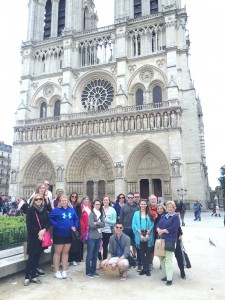 A photo stop by the Eiffel Tower gives the local guide an opportunity to share interesting facts, including a discussion on the weight of paint, and the suggestion that before the tower can be painted again it is likely that the layers of paint already on the tower will need to be removed to maintain its structural integrity. Next stop is Notre Dame which includes a discussion about the history of the cathedral, its architectural legacy, social and political influences and interesting facts about interior details and displayed objects… including the crown of thorns worn by Christ and a sliver from his cross.
A photo stop by the Eiffel Tower gives the local guide an opportunity to share interesting facts, including a discussion on the weight of paint, and the suggestion that before the tower can be painted again it is likely that the layers of paint already on the tower will need to be removed to maintain its structural integrity. Next stop is Notre Dame which includes a discussion about the history of the cathedral, its architectural legacy, social and political influences and interesting facts about interior details and displayed objects… including the crown of thorns worn by Christ and a sliver from his cross. 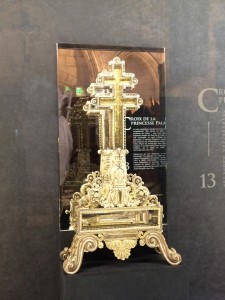 Everyone is given the opportunity to tour the cathedral at their leisure, visit the surrounding area with a stop for lunch, check out the books at Shakespeare & Co., where I encourage a purchase that includes a stamp inside the cover as a special souvenir and most important a chance to share first impressions. The cathedral is always larger than expected, the windows are more beautiful than imagined, the artifacts are more special and the experience is the first step in our global enlightenment. And just think… we have yet to check into our hotel. That does become our next stop though, where we freshen up and then off to our first dinner in Paris. And so the first day comes to an end, and already a sense of change is upon us. Anticipation of the next day is only calmed by the complete need of a good night sleep to prepare us for the second day of our wonderful adventure.
Everyone is given the opportunity to tour the cathedral at their leisure, visit the surrounding area with a stop for lunch, check out the books at Shakespeare & Co., where I encourage a purchase that includes a stamp inside the cover as a special souvenir and most important a chance to share first impressions. The cathedral is always larger than expected, the windows are more beautiful than imagined, the artifacts are more special and the experience is the first step in our global enlightenment. And just think… we have yet to check into our hotel. That does become our next stop though, where we freshen up and then off to our first dinner in Paris. And so the first day comes to an end, and already a sense of change is upon us. Anticipation of the next day is only calmed by the complete need of a good night sleep to prepare us for the second day of our wonderful adventure.
Villa Maria College students take 1st, 2nd and 3rd in ASID competion!
The American Society of Interior Designers (ASID) has announced the winners of the Upstate New York and Eastern Canada Network 2012 design competition. There are three professional categories including Residential, Commercial under 3,000 square feet and Commercial over 3,000 square feet plus one student competition category. Winners for 1st, 2nd and 3rd place are awarded in each. In the student competition category all three winning entries are from the Interior Design program at Villa Maria College.  Third place, for her Studio 5 Dzintari Health and Wellness Center is Sandra Zygaj Borowski. The project location is Latvia, in the city of Sigulda.
Third place, for her Studio 5 Dzintari Health and Wellness Center is Sandra Zygaj Borowski. The project location is Latvia, in the city of Sigulda.  Students Skype with the project architect, Gunta Graudupe as well as the owner/client Dr. Anda Polna. Ms. Zygaj Borowski researched Latvian folklore and history, selecting the symbol of the Cross Hatch Star to inspire her design.
Students Skype with the project architect, Gunta Graudupe as well as the owner/client Dr. Anda Polna. Ms. Zygaj Borowski researched Latvian folklore and history, selecting the symbol of the Cross Hatch Star to inspire her design.  The second place winner, for her Studio 4 Sephora Pop-Retail Design is Savana Czekalski. The students in this studio travelled to New York City to visit the newest Sephora retail store, gain first hand knowledge of the business and study other examples of retail design.
The second place winner, for her Studio 4 Sephora Pop-Retail Design is Savana Czekalski. The students in this studio travelled to New York City to visit the newest Sephora retail store, gain first hand knowledge of the business and study other examples of retail design.  Ms. Czekalski based her design on the concept, ‘Tis the Season to be Pretty. The first place winner, also for the Studio 5 project in Latvia was also Savana Czekalski.
Ms. Czekalski based her design on the concept, ‘Tis the Season to be Pretty. The first place winner, also for the Studio 5 project in Latvia was also Savana Czekalski.  Students were required to design sustainable interiors applying universal design principles and reflecting the unique cultural and regional properties of the location in Latvia.
Students were required to design sustainable interiors applying universal design principles and reflecting the unique cultural and regional properties of the location in Latvia.  The projects were also critiqued by Professor Daina Gaga, from the Latvia Culture College located in Riga, Latvia. Both studios are taught in the Junior year.
The projects were also critiqued by Professor Daina Gaga, from the Latvia Culture College located in Riga, Latvia. Both studios are taught in the Junior year.  Faculty advisor for Studio 4 is Professor Paul Brinkworth and Faculty advisor for Studio 5 is Professor Sandra Reicis.
Faculty advisor for Studio 4 is Professor Paul Brinkworth and Faculty advisor for Studio 5 is Professor Sandra Reicis.
Western Australian Flora……..
 If nature is inspiration…….Australia is its home.
If nature is inspiration…….Australia is its home.  Upon my recent visit to Australia I visited King’s Park and Botanic Garden in Perth. The beauty includes gardens of indigenous wild flowers, majestic trees, fascinating wildlife and expansive views of the City of Perth and Swan River.
Upon my recent visit to Australia I visited King’s Park and Botanic Garden in Perth. The beauty includes gardens of indigenous wild flowers, majestic trees, fascinating wildlife and expansive views of the City of Perth and Swan River. 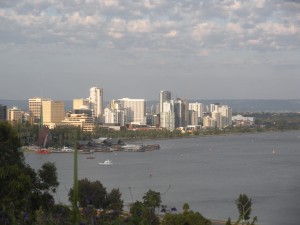 Refered to as ‘the bush in the city’, it is a popular destination to stroll, play, relax and learn. Originally named ‘The Perth Park’ when it was founded in 1890, the part was renamed ‘Kings Park’ to mark the accession of King Edward VII to the British Throne. The Western Australian Botanic Garden opened in 1965 and includes about 2,300 species of mainly Western Australian plants.
Refered to as ‘the bush in the city’, it is a popular destination to stroll, play, relax and learn. Originally named ‘The Perth Park’ when it was founded in 1890, the part was renamed ‘Kings Park’ to mark the accession of King Edward VII to the British Throne. The Western Australian Botanic Garden opened in 1965 and includes about 2,300 species of mainly Western Australian plants.  An interesting fact….the south west of Western Australia is Australia’s only terrestrial biodiversity hotspot, with more than 315 rare plant species. Western Australia has a rich collection of over 12,500 native plant species representing about 5% of the recorded vascular plant species on Earth.
An interesting fact….the south west of Western Australia is Australia’s only terrestrial biodiversity hotspot, with more than 315 rare plant species. Western Australia has a rich collection of over 12,500 native plant species representing about 5% of the recorded vascular plant species on Earth.  Over 80% of the plant species in Western Australia are unique to the area, found nowhere else on earth. The natural connection of art and nature is integrated with the Botanic Gardens and Parks Authority support for art and craft through its ownership and management of Aspects of Kings Park Gallery Shop’
Over 80% of the plant species in Western Australia are unique to the area, found nowhere else on earth. The natural connection of art and nature is integrated with the Botanic Gardens and Parks Authority support for art and craft through its ownership and management of Aspects of Kings Park Gallery Shop’  The shop is considered of international standard and offers art and design pieces reflective of the integration of conservation and environmental education.
The shop is considered of international standard and offers art and design pieces reflective of the integration of conservation and environmental education. 
Villa Student Projects Presented in Australia…..
IDEA, the Interior Design/Interior Architecture Educators Association is comprised of universities from Australia and New Zealand offering programs in interior design and interior architecture.  This year their conference and exhibition, Interior Design:- a state of becoming, was held September 6 to 10 in Perth, Australia, hosted by Curtin University.
This year their conference and exhibition, Interior Design:- a state of becoming, was held September 6 to 10 in Perth, Australia, hosted by Curtin University.  The conference opening coincided with the exhibition opening, An Interior Affair: A State of Becoming. This was held at Form gallery. Curators fo the show are Marina Lommerse, Curtin University, Australia Jane Lawrence, University of South Australia, Australia Sven Mezhoud, Monash University, Australia Stuart Foster, Massey University, New Zealand. The event was also covered by Gallery Watch, a television program dedicated to support and promotion of the Australian art scene.It was an excellent event to bring all conference participants together to socialize, theorize, meet and greet. delegates had expectedly travelled from across Australia and New Zealand but also included South Africa, Indonesia, United Kingdom, Canada, United States and other countries.http://www.youtube.com/watch?v=Jjo22EpFuAU
The conference opening coincided with the exhibition opening, An Interior Affair: A State of Becoming. This was held at Form gallery. Curators fo the show are Marina Lommerse, Curtin University, Australia Jane Lawrence, University of South Australia, Australia Sven Mezhoud, Monash University, Australia Stuart Foster, Massey University, New Zealand. The event was also covered by Gallery Watch, a television program dedicated to support and promotion of the Australian art scene.It was an excellent event to bring all conference participants together to socialize, theorize, meet and greet. delegates had expectedly travelled from across Australia and New Zealand but also included South Africa, Indonesia, United Kingdom, Canada, United States and other countries.http://www.youtube.com/watch?v=Jjo22EpFuAU
The conference theme explored the world of the interior as a state of constant and dynamic ‘becoming’ rather than ‘being’. Asking questions such as:- how do we reconsider the interior and the occupant becoming ‘old’? Where is the value in constantly ‘becoming’ new? How do we re-vision the history of interiors in the light of ‘becoming’? What are the potential roles and responsibilities for Interior Designers / Architects in addressing becoming homeless and ‘being’ disadvantaged?  Sandra Reicis, Associate Professor of Interior Design at Villa Maria College, Buffalo, New York, saw the relationship to a recent Villa student project. The submitted abstract was reviewed by the conference committee and selected for presentation. “The Millennium Dream Home: quality of life and quality of surroundings”, documented the project research and design process, including the work of sophomore level students Harrison Walsh and Jillian Schultz.
Sandra Reicis, Associate Professor of Interior Design at Villa Maria College, Buffalo, New York, saw the relationship to a recent Villa student project. The submitted abstract was reviewed by the conference committee and selected for presentation. “The Millennium Dream Home: quality of life and quality of surroundings”, documented the project research and design process, including the work of sophomore level students Harrison Walsh and Jillian Schultz.  Challenged to re-think and re-define the American Dream Home the projects demonstrated inclusiveness and domicile adaptiveness, drawing on historical precedent and universal design principles to create well-designed and beautiful interior spaces. As demonstrated in the student diagram above, the use of rotation was integral to the final form and spatial design of the first floor plan by Walsh. Design inspiration was derived from works of fine art on display at the Albright Knox Art Gallery in Buffalo, NY.
Challenged to re-think and re-define the American Dream Home the projects demonstrated inclusiveness and domicile adaptiveness, drawing on historical precedent and universal design principles to create well-designed and beautiful interior spaces. As demonstrated in the student diagram above, the use of rotation was integral to the final form and spatial design of the first floor plan by Walsh. Design inspiration was derived from works of fine art on display at the Albright Knox Art Gallery in Buffalo, NY.  This fused glass piece, crafted by Schultz, was an inspiration from a work by Georgia O’Keefe. The story behind the art piece led Schultz to an exploration of courtyards and passageways, which became integral to her final project.
This fused glass piece, crafted by Schultz, was an inspiration from a work by Georgia O’Keefe. The story behind the art piece led Schultz to an exploration of courtyards and passageways, which became integral to her final project. 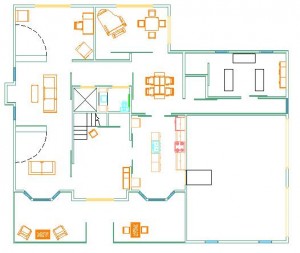 The paper was presented under the topic of interior: in its everydayness together with presentations by Jane Simon, MacQuarie University, Sydney, Australia, Vanessa Galvin, Curtin University, Perth, Australia and Mary Anne Beecher, University of Manitoba, Winnipeg, Canada. Other topics included interior: in flux, interior: as performance and interior: as virtual. The conference included Keynote speakers, Beatriz Colomina, see Interior Design live wire and Charles Rice. Images of the gallery show can be downloaded here.
The paper was presented under the topic of interior: in its everydayness together with presentations by Jane Simon, MacQuarie University, Sydney, Australia, Vanessa Galvin, Curtin University, Perth, Australia and Mary Anne Beecher, University of Manitoba, Winnipeg, Canada. Other topics included interior: in flux, interior: as performance and interior: as virtual. The conference included Keynote speakers, Beatriz Colomina, see Interior Design live wire and Charles Rice. Images of the gallery show can be downloaded here.
A visit to Sydney art galleries…..
Sydney has many museums and art galleries….and I was fortunate to visit two.  The Art Gallery of New South Wales, located in the Sydney Botanic Garden has a Classical facade, making it a city landmark, with a contemporary addition in the back which flows seamlessly on the interior. The permanent collection includes Australian, Aboriginal, European, Asian and Contemporary art.
The Art Gallery of New South Wales, located in the Sydney Botanic Garden has a Classical facade, making it a city landmark, with a contemporary addition in the back which flows seamlessly on the interior. The permanent collection includes Australian, Aboriginal, European, Asian and Contemporary art. Not only is entry to the gallery free, but there are also free daily guided tours. The addition includes two restaurants with outdoor patio seating. As part of the Botanic Gardens the local wildlife has discovered a wonderful location for their own mid-day snack. The birds seem to understand they need to wait patiently until the human guests have departed. Nonetheless the wait staff gently discourage the birds….although I was not the only amused patron taking photos of these feathered friends.
Not only is entry to the gallery free, but there are also free daily guided tours. The addition includes two restaurants with outdoor patio seating. As part of the Botanic Gardens the local wildlife has discovered a wonderful location for their own mid-day snack. The birds seem to understand they need to wait patiently until the human guests have departed. Nonetheless the wait staff gently discourage the birds….although I was not the only amused patron taking photos of these feathered friends.
The Museum of Contemporary Art is located in an area known as the Rocks and Circular Quay. It too has free admission. The collection began when Sydney art collector John Power died in 1943, leaving his entire collection to the University of Sydney.  By 1991 the collection, which included works by Hockney, Warhol, Lichtenstein and Christo was moved into the 1950’s Art Deco style building.
By 1991 the collection, which included works by Hockney, Warhol, Lichtenstein and Christo was moved into the 1950’s Art Deco style building.  The building has a contemporary entry that stands out on Circular Quay West. The interior of the building boasts a beautiful view of the harbour and Sydney Opera House, and is an excellent continuation of the exterior design aesthetic. Providing free admission may be a reason that the galleries are well attended by locals, tourists and school groups, and may help to explain the popularity of art in Australia.
The building has a contemporary entry that stands out on Circular Quay West. The interior of the building boasts a beautiful view of the harbour and Sydney Opera House, and is an excellent continuation of the exterior design aesthetic. Providing free admission may be a reason that the galleries are well attended by locals, tourists and school groups, and may help to explain the popularity of art in Australia.


